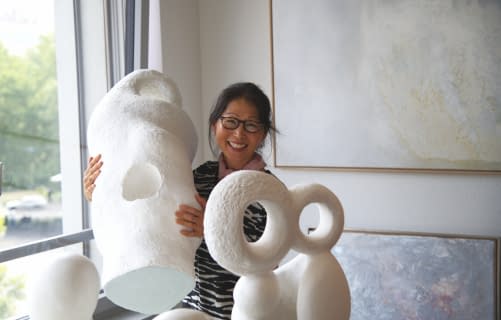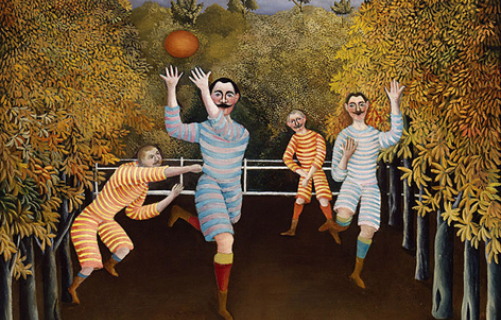Short Summary
Everyday Objects Seen in a New Light - Margot Ressel and Her Still Lifes
Margot Ressel is a contemporary artist who has dedicated herself to still lifes. Everyday objects on table surfaces end up on her canvas, as do beautiful flower arrangements. And then again she surprises with portraits of a versatile, beautiful woman and gently abstracted landscapes, never completely abandoning the figurative. The art24 team visited the Swiss artist in her studio in Tuttwil and at her exhibition at Stadtgalerie Baliere in Frauenfeld, which took place in April 2025. This led to exciting dialogues and insights into her way of working and thinking. Find out in this blog how Margot Ressel uses colour, light and harmonious compositions to evoke memories and emotions.
A Stroll Around the Studio
The sun is shining and a gentle spring awakening is in the air as the art24 team makes its way to visit Margot Ressel in her studio. In this intimate space, not only does her art reveal itself to us, but also her very own view of the world. We are curious to see what insights we are given into her work and her creations - in particular the ‘harmony of colours’, which she always emphasises as a central element and supporting pillar of her art.
The artist greets us at the railway station and takes us in her car across the countryside to her studio. We arrive at the old farmhouse in Tuttwil, where she has set up her studio in the attic. After climbing a narrow wooden staircase, a huge, bright room opens up. The studio covers the entire attic. The high ceilings and windows make the room unexpectedly bright and friendly, while the wood again radiates an intimate, cosy atmosphere. The bright light and the first spring colours outside in nature match the mood in the studio and the works we are about to see.
Works of art by Margot Ressel are everywhere on the walls. All the visual stimuli make it easy to get into conversation and as we stroll through the studio, dialogues about her art open up: from the beginnings, to her technique, the motifs, to her artistic development.
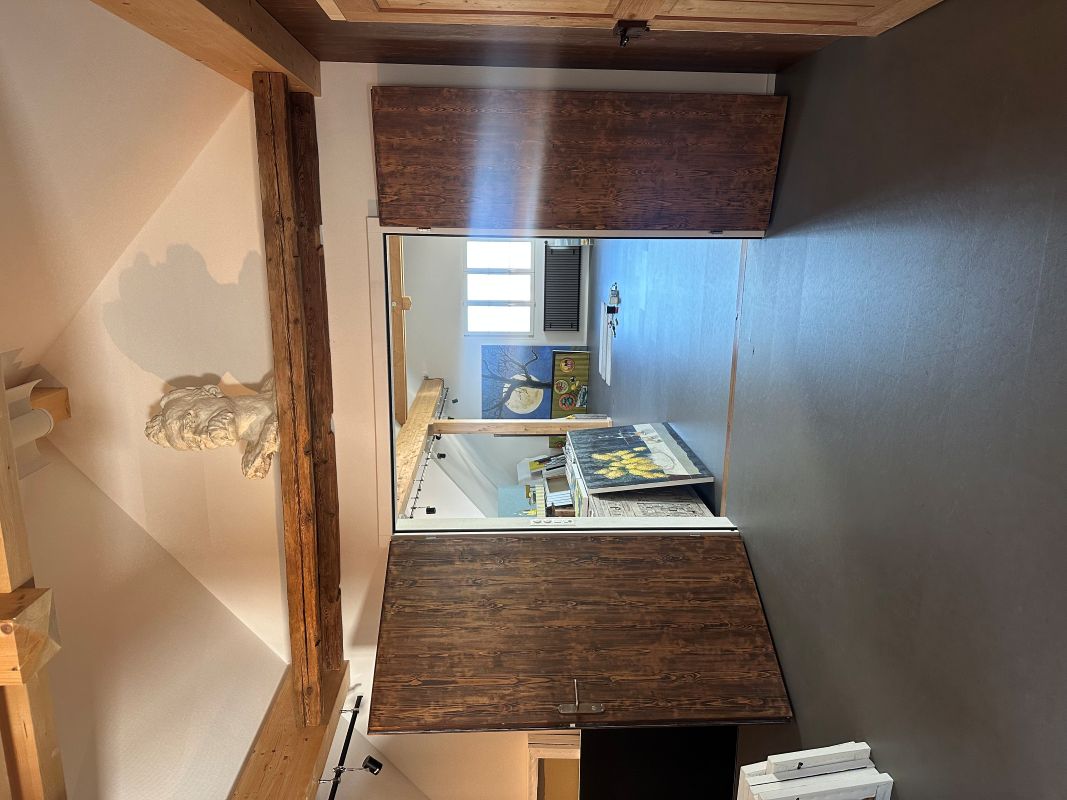
The first thing we notice are the painting utensils in her work corner: A selection of brushes, palette knives and colours. Several wooden palettes with dried paint hang on the wall. That's the difference between her and her father, she says, following our gaze. Her father, Erhard Ressel, also an artist, worked full-time as a restorer of important churches and paintings in Switzerland. While the colours on his palette are carefully and neatly applied one after the other in small blobs and are only slightly mixed, Margot Ressel's palette shows disordered and freely mixed fields of colour, which nevertheless manage to create a harmonious, cheerful feeling. Her father would not have liked to see such wild chaos. And that is what she means when she says that this is the difference between the two of them. But that was her way of breaking away from her father's strictly prescribed working practices, breaking away from him in order to discover her own way of working and expressing herself. Finding her own artistic language was therefore in itself a rebellious act, as she did so in the knowledge that she was nevertheless following in his footsteps.

We continue to wander through the studio and come across a painting depicting a black bistro table. On it stand fresh flowers, a green siphon, a poison-green cup and a water glass in which a sip of water still simmers as if someone had just sat at the table. Next to it is the now empty chair with a woven backrest and a patterned textile cushion on the seat. In the background we see a house façade with a green window shutter, which places us in front of a house. Green leaves hang down from the upper edge of the picture, hinting at a neighbouring tree that we can only guess at. The tree provides shade for the table so that cosy hours can be spent outside. The leaves cast soft shadows on the white façade. As a viewer, a past, warm summer day is recalled, a nostalgic feeling is awakened. The memory also brings the associated odours back to mind. But not only odours suddenly come back to life. You also think you can hear the gentle rustling of leaves, triggered by a warm, light breeze. And now we have a better understanding of what Margot Ressel means when she says that she is searching for the harmony of colours. In this scene, an interplay of colours is used to search for light and atmosphere that evoke calm and peace. A pictorial refuge that is transferred to the mind.
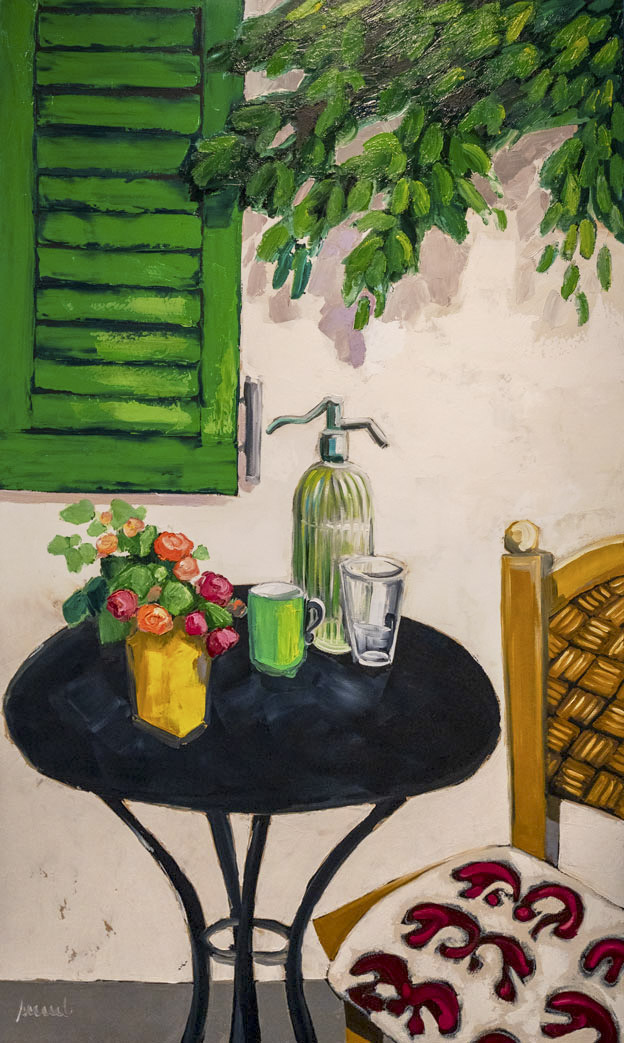
Still Life - An Adaptable Genre
Margot Ressel's still lifes should be viewed in real life. Only then can you recognise the brushstrokes, the structures and the effect of the colouring. The dimensions in relation to one's own body also help to make her art fully comprehensible. The bold colours in Ressel's art not only bring the captured light situation to life, but also appeal to all our sensory experiences. Her works thus trigger a personal connection. This is not only due to the colours, but also to her motifs, which seem so familiar to us. She is driven by the search for harmony in the colours. The picture should be coherent in itself, but for her that doesn't mean that the colours can't be bright or surprising. Somehow she always manages to create a harmonious and fitting overall picture, even if it doesn't always seem that way at first glance. This also shows that a closer look at the painting reveals new things to us. Sometimes she paints with the same colours in the different pictures, but each time they take on a different role. The forms also have an influence. Colours and shapes are therefore not limited in their expressiveness, but always work in relation to each other.
Ressel's way of working also involves a playful approach. Sometimes she leaves things out that attentive viewers notice. For example, certain shadows that would be expected. This is what makes an authentic Ressel painting. She does this simply because she can and because certain things seem more important at that moment than accurate representation. Margot Ressel rarely carries out customer commissions. Although there have been a few that have been successfully completed, her experience is that this is often not feasible. Because if customers specify too much, then something is created without her own energy, her own drive, and that doesn't work for her.
Still lifes and objects from nature are an important source of inspiration for Margot Ressel. Sometimes she also picks up on surrounding objects, but she finds the classic themes of oil painting the most exciting. From time to time she also paints seascapes. She finds the view of the sea and the tranquillity of her memories to be beautiful work. Nevertheless, she is always drawn to classical subjects, which she drapes and translates into a modern visual language. This interest has its origins in her father's workshop. This love of figurative art has never ceased. Although many artists move towards abstraction over time, this was never the case with Margot Ressel. Rather the opposite. Her interest in the figurative has intensified. Margot Ressel found other ways to explore new terrain. For example, when she inherited her father's paintbrushes, she started working with them about two years ago. The bristles of his brushes were too fine for her for a long time. But now she has discovered how to work with them and thus also a new form of expression for her figurative art. She now also works on the backgrounds differently than before. She throws other colour tones over the base colour to create more depth and incorporate a liveliness so that people pay more attention to them. Although she began her artistic career with mixed media on photographic cardboard, she soon discovered oil colours as her preferred medium - a technique to which she has remained faithful to this day. She was no stranger to oil colours, as she was already familiar with them from her father's work. She still experiments with them today and is always looking for new forms of expression. However, the slow drying of the colours requires patience and only allows a step-by-step approach.
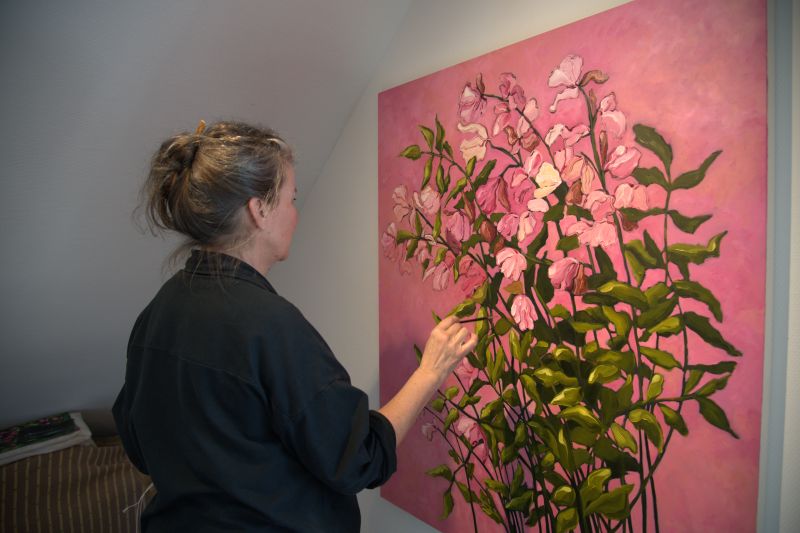
Tablescapes of Emotions - Of Flowers, Shapes and Retreat
Still lifes can be put together and laid out as desired. The tables in her paintings not only fulfil the function of a storage surface for the painted everyday objects. They create connotations of a cosy home, of coming together and socialising. They are something familiar and sheltered. Even if the shape of the table is not always accurate, the reference is always there. In addition to the harmony in her works, Margot Ressel also wants her art to express something positive. We usually find positive thoughts in our familiar surroundings, in places where we can retreat and feel safe. In addition to private spaces, Margot Ressel is also fascinated by flowers. She finds the fact that you can arrange them however you like particularly interesting. She often looks for beautiful shapes and colours in her own flower garden, which is full of wildflowers and colourful, lively hustle and bustle. Flowers allow a playful approach, can be reorganised and put together. She describes this ‘journey’ in search of the right shapes and colour combinations as an exciting challenge. Like the contradictory shadows, the flowers are not true-to-life reproductions. Although Margot Ressel draws on nature, she does not claim that they are exactly recognisable. As a result, her works also reveal something enigmatic.
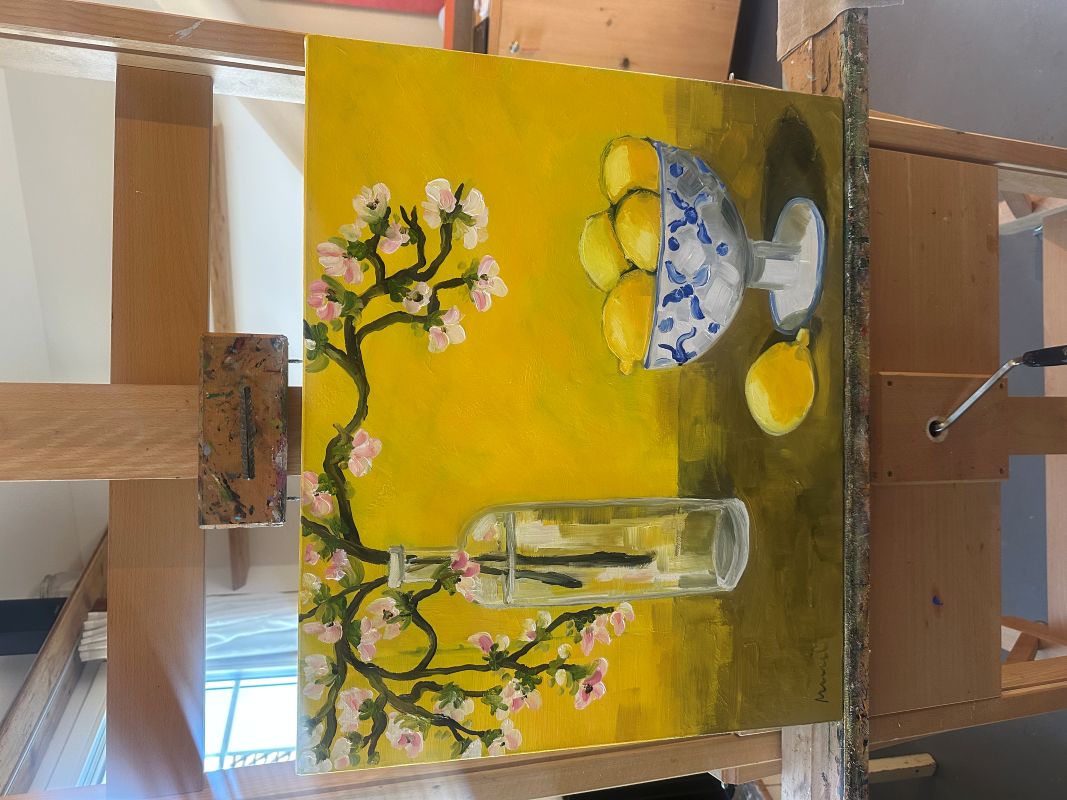
On our stroll through the studio, we also notice that her few seascape paintings seem more pensive in comparison to the colourful still lifes. When asked how she combines this melancholy mood with the claim to positivity in her paintings, she replies that tranquillity and melancholy are not necessarily negative for her. Because they also have something beautiful in them. Moments of tranquillity and introspection can also be chosen and a conscious decision to engage with them can be made. For her, these are phases of retreat and regeneration, which she does not see as something gloomy, but as something essential for people and something she can deal with well. Her landscapes reflect this quiet, inward-looking mood - they are more reserved in expression, more mysterious and more abstract in form than the referential still lifes that seem anchored in life.
Memories in Shape and Colour
At her exhibition, the artist showed a number of older works but mainly recent works that she has created over the last two years. This exhibition was an exciting step for Margot Ressel, as it was the first time she had exhibited in Frauenfeld and opened up a whole new audience for her. The dialogue with other people through her art is an important aspect for Margot Ressel. She wants to trigger impressions and feelings that are based on people's own memories and are evoked again. We were able to experience this during our visit to the studio and in the exhibition itself, as the objects and the atmosphere in the artworks also made our memories flicker. Whether it was the green siphon or the shutters that made us think of summer days in the south, or the flowers in the garden that reminded us of our childhood. The shapes of these objects do not have to be reproduced accurately and realistically, says Ressel. It's the impressions that count. A certain shade of colour can also be enough to evoke memories. So you quickly realise what art can trigger in us. And although the pictures speak for themselves, as they are figurative, you can immerse yourself in long conversations through each picture, says Ressel. So everyone brings their own interpretations, perceptions and feelings to a work of art.
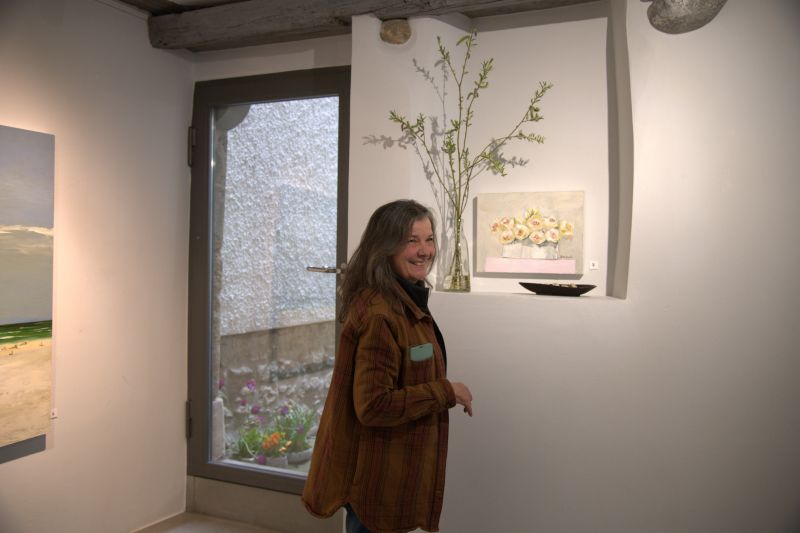
Still Life, Flower and Landscape Paintings - Boring and Apolitical?
Margot Ressel often encounters prejudices when she is asked what kind of art she makes. Still lifes, floral and landscape motifs are initially perceived by some as uninteresting. But for Margot Ressel, art can also be ‘simply’ beautiful and touching on an aesthetic level. Many visitors are pleasantly surprised when they actually see her work. Art doesn't always have to be political or provocative - it can also have an impact through its beauty and stimulate thought. For Ressel, it is crucial that a work triggers something, that people feel addressed by it. And sometimes, she says, nothing happens - that's okay too.
Margot Ressel thus withdraws from the political, offering the eye and soul something aesthetic and relaxed, a place of rest. The still life is also located in this tradition of the enjoyment of forms, colours and composition and as a place of contemplation. Art does not always have to be a confrontation, it can also be a place of relaxation. So Margot Ressel indirectly becomes political again: because abstaining, relaxing and paying attention also harbours something rebellious and unique. Taking yourself out of everything and finding peace for a moment does you good. Margot Ressel's art is therefore detached from modern tendencies to frighten or seize. The objects on her tables refer to our everyday lives, they are tangible and at the same time they emphasise what we are presented with: Art - something made, created. Just as we like it. And as Margot Ressel tells us with a few examples, art also has an immense transformative power. Her works of art contain an energy of their own that can influence our surroundings, our living space, our well-being and our daily attitude to life. Margot Ressel's art thus becomes a gentle yet powerful invitation to turn towards beauty - as a conscious act of self-care, retreat and enjoyment.
The artist is happy to welcome interested parties to her studio to give them the opportunity to experience her works in person.
Here you can find her art24 profile.
Author: Yvonne Roos



